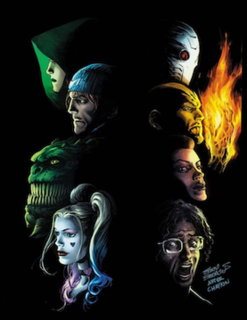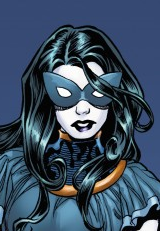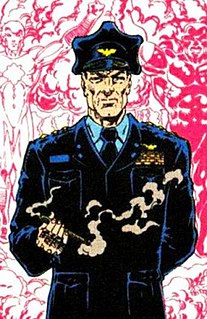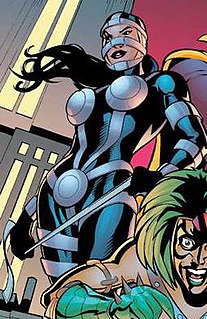Related Research Articles
The Atom is a name shared by five fictional comic book superheroes from the DC Comics universe.

Captain Atom is a fictional superhero appearing in American comic books published by DC Comics. Captain Atom has existed in three basic incarnations.

The Suicide Squad is a fictional antihero team appearing in American comic books published by DC Comics. The first version of the Suicide Squad debuted in The Brave and the Bold #25 and the second and modern version, created by John Ostrander, debuted in Legends #3.

Nightshade is a fictional character, a comic book superheroine published by DC Comics. Created by David Kaler and Steve Ditko, the character first appeared in Captain Atom v1 #82 originally published by Charlton Comics.

Captain Boomerang is a fictional supervillain appearing in American comic books published by DC Comics. The character is an enemy of both the Barry Allen and Wally West versions of the Flash. Created by writer John Broome and artist Carmine Infantino, Captain Boomerang first appeared in The Flash #117. He has also been a prominent member of the Suicide Squad since its second iteration in the late 1990s. During the 2004 storyline Identity Crisis, George Harkness is killed and his son, Owen Mercer, takes over his father's role as Captain Boomerang for a period of time. However, during the 2009–2010 Blackest Night storyline, Owen is killed and Harkness returns to life, resuming his role as Captain Boomerang.
Deadshot is a fictional character appearing in American comic books published by DC Comics. Created by David Vern Reed, Lew Schwartz, and Bob Kane, the character made his first appearance in Batman #59. He is an excellent sniper who regularly boasts of never missing a shot, and is often considered as one of the deadliest assassins in the DC Universe. Deadshot is an adversary of the superhero Batman and belongs to the collective of enemies that make up his rogues gallery. Though normally portrayed as a supervillain, he is sometimes depicted as an antihero.

Count Vertigo is a fictional supervillain created by Gerry Conway, Trevor Von Eeden and Vince Colletta as an enemy of Black Canary and later Green Arrow in the DC Comics Universe. Count Vertigo is the last descendant of the royal family that ruled the small eastern European country of Vlatava that was taken over by the Soviets and later became devastated by the Spectre.

Amanda Blake Waller is a fictional character appearing in American comic books published by DC Comics. The character first appeared in Legends #1 in 1986, and was created by John Ostrander, Len Wein, and John Byrne. Amanda Waller is an antagonist and occasional ally to the superheroes of the DC Universe.

Justice League Europe (JLE) was a comic book series published by DC Comics that was a spin-off of the comic book Justice League America.

Rick Flag is the name of three fictional characters appearing in American comic books published by DC Comics. They are father, son, and grandson.

Livewire is a fictional supervillainess appearing in comic books published by DC Comics. Originally created for Superman: The Animated Series, the character appeared in March 1997 in Superman Adventures #5. Her first mainstream comic book appearance was in Action Comics #835.

Invasion! was a three issue comic book limited series and crossover event published in late 1988-early 1989 by DC Comics. It was plotted by Keith Giffen, and ties up a great many plotlines from various Giffen-created DC series, including Omega Men, Justice League International, and Legion of Super-Heroes. A trade paperback collection of the three issues was released on September 3, 2008.

General Wade Eiling, sometimes known as The General, is a villain who appears in comics published by DC Comics.

The Thinker is the name of four fictional characters, all supervillains appearing in comic books published by DC Comics.

Killer Frost is a name used by several fictional female supervillains and superheroes appearing in comic books published by DC Comics: Crystal Frost, Louise Lincoln, and Caitlin Snow. Each different individual in the DC Universe assuming the Killer Frost persona is usually as an adversary of the superhero Firestorm.

Lashina is a fictional character, a supervillainess and Goddess warrior published by DC Comics.
Punch and Jewelee are supervillains in the DC Universe. They originally battled Captain Atom and Nightshade and later joined the Suicide Squad.

King Shark (Nanaue) is a fictional supervillain appearing in comic books published by DC Comics. The character was created by writer Karl Kesel and artist Tom Grummett. King Shark first appeared in Superboy #0 as a cameo before making his first full appearance in Superboy #9.
Advanced Research Group Uniting Super-Humans is the name of a government organization in DC Comics. A.R.G.U.S. first appeared in Justice League Vol. 2 #7 and was created by Geoff Johns and Gene Ha.
References
- ↑ Cowsill, Alan; Irvine, Alex; Korte, Steve; Manning, Matt; Wiacek, Win; Wilson, Sven (2016). The DC Comics Encyclopedia: The Definitive Guide to the Characters of the DC Universe. DK Publishing. p. 232. ISBN 978-1-4654-5357-0.
- 1 2 3 4 Rovin, Jeff (1987). The Encyclopedia of Supervillains. New York: Facts on File. p. 268. ISBN 0-8160-1356-X.
- ↑ Beatty, Scott (2008). "Extreme Justice". In Dougall, Alastair (ed.). The DC Comics Encyclopedia. New York: Dorling Kindersley. p. 117. ISBN 978-0-7566-4119-1. OCLC 213309017.
- ↑ Justice League of America (vol. 3) #43
- ↑ Justice League (vol. 2) #22
- ↑ Justice League of America (vol. 3) #7
- ↑ Forever Evil: Rogues Rebellion #1
- ↑ Misiroglu, Gina Renée; Eury, Michael, eds. (2006). The Supervillain Book: The Evil Side of Comics and Hollywood. Visible Ink Press. ISBN 978-1578591787.
- 1 2 3 Green, Paul (2016). Encyclopedia of Weird Westerns (2 ed.). McFarland. ISBN 978-1476662572.
- ↑ Chance, Norman (2011). Who was Who on TV Volume III. Xlibris. p. 223. ISBN 978-1-4568-2455-6.
- ↑ Don Whitehead, Holly Henderson (writers) & Rick Rosenthal (director) (2008-09-25). "Plastique". Smallville. Season 8. Episode 2. The CW.
- ↑ Todd Slavkin, Darren Swimmer (writers) & Greg Beeman (director) (2005-05-18). "Commencement". Smallville. Season 4. Episode 22. The WB.
- ↑ Al Septien, Turi Meyer (writers) & Tom Welling (director) (2009-05-07). "Injustice". Smallville. Season 8. Episode 21. The CW.
- ↑ Bricker, Tierney (2014-07-29). "The Flash Casting Scoop: It's Time to Meet Plastique". E! . Retrieved 2020-11-27.
- ↑ Moore, Trent (2015-06-26). "Here's who'll be playing DC character Plastique on S1 of The CW's Flash". Syfy Wire . Retrieved 2020-11-26.
- ↑ Harp, Justin (2014-07-24). "The Flash to introduce DC Comics character Plastique". Digital Spy . Retrieved 2020-11-26.
- 1 2 Paige, Rachel (2014-11-11). "Plastique May Be Getting a Heroic 'Flash' Makeover". Bustle . Retrieved 2020-11-26.
- ↑ Von Doviak, Scot (2014-11-11). "The Flash: "Plastique"". The A.V. Club . Retrieved 2020-11-26.
- ↑ Reeves, Brianna (2017-12-17). "8 Characters the Arrowverse Does Better Than Smallville (And 7 That Are Worse)". CBR . Retrieved 2020-11-26.
- ↑ Böhme, Felix (2014-11-12). "The Flash 1x05 Plastique". Serienjunkies. Retrieved 2020-11-26.
- ↑ Frankenhoff, Brent (2012). "Plastique". Dangerous Curves: Comics' Sexiest Bad Girls. Krause Publications. ISBN 978-1440235009.